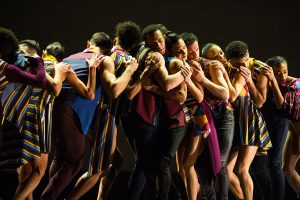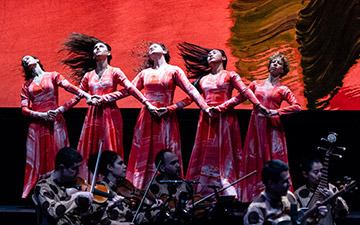
© Susana Millman. (Click image for larger version)
Mark Morris Dance Group
Layla and Majnun
★★★✰✰
Berkeley, Zellerbach Hall
30 September 2016
www.markmorrisdancegroup.org
calperformances.org
A friend said to me the other day, “People go to see Mark Morris for the music.” We were discussing the upcoming world premiere of Mark Morris Dance Group’s Layla and Majnun, and why she, a dancer, wouldn’t be seeing it. The truth is not as unequivocal as that – clearly, Morris’ choreography has as many adherents as his exquisite taste in music and musical collaborators.
But judging by the applause at Zellerbach Hall, where Layla and Majnun opened on Friday, 30 September, people really were there for the music. At the curtain call, they clapped respectfully for the fifteen dancers, huzzahed for the Silk Road Ensemble and stood up and cheered for the two vocalists, Azerbaijani father-daughter mugham singers Alim Qasimov and Fargana Qasimova. It was a fair assessment of the 50-minute work, for which the music was exquisite but the slight choreography was tastefully decorative when not cloyingly frilly.
Co-produced and presented by Cal Performances, Layla and Majnun is a theatrical adaptation of a 7th-century Persian legend of unrequited love, as codified by the 12th-century poet Nizami Ganjavi. Azerbaijani composer Uzeyir Hajibeyli wrote an operatic treatment in 1908, and Yo-Yo Ma’s Silk Road Ensemble’s chamber adaptation became the score for Morris’ version. The admixture of Eastern (kamansheh, tar, shakuhachi, pipa) and Western (violin, viola, cello, bass) instruments brought a marvelously lyrical softness to the plaintive song cycle on unrequited love.

© Susana Millman. (Click image for larger version)
According to the Legend, the young Layla and her suitor, Majnun, are hopelessly enamored but barred from marrying by her parents, who are put off by Majnun’s peculiar, obsessive behavior – public declarations of love, writing maudlin free verse like “My only wish is to perish in the world of love.” Layla’s parents force her into an arranged marriage, which she refuses to consummate; she perishes, he perishes, and they reunite in the afterlife for an eternity of ethereal devotion.
It would be hard to name a musical experience more transcendent. Though English supertitles of Majnun’s teenage sentiments drew giggles from the olders and wisers in the audience, the opera offers a near-magical opportunity to contemplate life’s bittersweetness. Extended instrumental bridges between sung passages serve as pauses for thought, opportunities to get past wink-wink cynicism and reach a place of reflection.
However, in Morris’ iteration, every moment was filled with dancing – some as genuinely sublime, much of it distractingly arch. Eight men and seven women snaked between and around the musicians, holding hands, hopping about in Morris’ familiar fast-fast-slow tempo, stamping their heels kathak-style, crouching and arching. The chipper folksiness seemed straight out of L’Allegro, il Penseroso ed il Moderato; it suits the Handel perfectly but feels trite in a work created 28 years later. There is much to be gained from simply allowing the music to wash over the listener; illustrating every beat was not necessary.
For all the hop-skipping silliness, Layla and Majnun is abundant with technical bravura. And to a one, the dancers – Sam Black, Rita Donahue, Domingo Estrada Jr., Lesley Garrison, Lauren Grant, Brian Lawson, Aaron Loux, Laurel Lynch, Stacy Martorama, Dallas McMurray, Brandon Randolph, Nicole Sabella, Billy Smith, Noah Vinson and Michelle Yard – exceeded Morris’ past precedents of movement.
Where Morris succeeded beautifully was in melding Eastern dance styles into his balletic modern vocabulary in deep torso bends, dervish whirls and arms extended beyond his already expansive port de bras. He created a body language of longing and impassable spiritual distance through embraces that never touch, paused lunges, skirt hems raised to wipe mournful tears. And if he was predictably canonical at times, he also created mesmerizing mirrored phrases. Some of the choreography demanded as much courage as skill, like a series of downstage cabrioles, done in full layout with one arm raised and head thrown back, eyes gazing at the ceiling.

© Susana Millman. (Click image for larger version)
Each of the work’s five named, 10-minute acts ends in a lovely tableau vivant, backlit in silhouette, like the closing of a chapter. A different male-female pair portrayed the title roles in each section, and each contributed unique physicality; the most compelling was Sabella and a mustachioed Estrada in Act II, “The Parents’ Disapproval.”
Gifted at the subtlest mime, which is all that Morris called for – and all that the work needed – they exuded the powerful emotions of the text; in their favor were villains to play against, in parents (Grant and Vinson, Yard and Smith) who forced them apart. At the emotional peak of their pas de deux, Estrada crosses to center stage and toward Sabella, advancing by développé into arabesque, then turning and repeating, turning and repeating; moving toward him in inverted phrasing, she opens to arabesque and closes into enveloppé, turns and repeats, turns and repeats. Fresh and unexpected, that choreography seemed to emerge organically along with the music, and the difficulty of executing it seemed to push the dancers out of the cerebral and into the immediate. At those moments, we were in their thrall.
Howard Hodgkin designed the set and the expressionistic backdrop, with wide swaths of photoreactive paint. He also designed the costumes: for the men, electric blue tunics and white pants; for the women, beautifully cut dresses in strident orange-and-white that added nothing but visual noise. James F. Ingalls manipulated perceptions with masterful lighting.
Layla and Majnun will tour the United States and internationally.

















You must be logged in to post a comment.